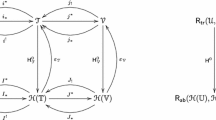Abstract
The Nakayama conjecture states that an algebra of infinite dominant dimension should be self-injective. Motivated by understanding this conjecture in the context of derived categories, we study dominant dimensions of algebras under derived equivalences induced by tilting modules, specifically, the infinity of dominant dimensions under tilting procedure. We first give a new method to produce derived equivalences from relatively exact sequences, and then establish relationships and lower bounds of dominant dimensions for derived equivalences induced by tilting modules. Particularly, we show that under a sufficient condition the infinity of dominant dimensions can be preserved by tilting, and get not only a class of derived equivalences between two algebras such that one of them is a Morita algebra in the sense of Kerner–Yamagata and the other is not, but also the first counterexample to the question whether generalized symmetric algebras are closed under derived equivalences.
Similar content being viewed by others
References
M. Auslander, M. I. Platzeck and G. Todorov, Homological theory of idempotent ideals, Transactions of the American Mathematical Society 332 (1992), 667–692.
M. Auslander, I. Reiten and S. O. Smalø, Representation Theory of Artin Algebras, Cambridge University Press, Cambridge, 1995.
M. Broué, Equivalences of blocks of group algebras, in Finite Dimensional Algebras and Related Topics, (V. Dlab and L. L. Scott, eds.) Kluwer, 1994, 1–26.
H. X. Chen, S. Y. Pan and C. C. Xi, Inductions and restrictions for stable equivalences of Morita type, Journal of Pure and Applied Algebra 216 (2012), 643–661.
Y. P. Chen, Derived equivalences between subrings, Communications in Algebra 42 (2014), 4055-4065.
R. R. Colby, Tilting modules, dominant dimension and exactness of duality functors, Tsukuba Journal of Mathematics 12 (1988), 441–449.
M. Fang, W. Hu and S. Koenig, Derived equivalence and dominant dimension for Morita algebras, 2014, preprint.
M. Fang and S. König, Endomorphism algebras of generators over symmetric algebras, Journal of Algebra 332 (2011), 428–433.
D. Happel, Triangulated Categories in the Representation Theory of Finite Dimensional Algebras, Cambridge University Press, Cambridge, 1988.
D. Happel, Reduction techniques for homological conjectures, Tsukuba Journal of Mathematics 17 (1993), 115–130.
W. Hu, S. König and C. C. Xi, Derived equivalences from cohomological approximations, and mutations of Yoneda algebras, Proceedings of the Royal Society of Edinburgh Section A 143 (2013), 589–629.
W. Hu and C. C. Xi, D-split sequences and derived equivalences, Advances in Mathematics 227 (2011), 292–318.
W. Hu and C. C. Xi, Derived equivalences and stable equivalences of Morita type, I, Nagoya Mathematical Journal 200 (2010), 107–152.
B. Keller, Derived categories and their uses, in Handbook of Algebra, Vol. 1, North-Holland, Amsterdam, 1996, pp. 671–701.
O. Kerner and K. Yamagata, Morita algebras, Journal of Algebra 382 (2013), 185–202.
J. Koch, Frobenius Algebras and 2D Topological Quantum Field Theory, London Mathematical Society Student Texts 59, Cambridge University Press, Cambridge, 2004.
S. P. Liu and R. Schulz, The existence of bounded infinite DTr-orbits, Proceedings of the American Mathematical Society 122 (1994), 1003–1005.
J. Miyachi, Injective resolutions of Noetherian rings and cogenerators, Proceedings of the American Mathematical Society 128 (2000), 2233–2242.
B. Mueller, The classification of algebras by dominant dimension, Canadian Journal of Mathematics 20 (1968), 398–409.
S. Y. Pan and C. C. Xi, Finiteness of finitistic dimension is invariant under derived equivalences, Journal of Algebra 322 (2009), 21–24.
J. Rickard, Morita theory for derived categories, Journal London Mathematical Society 39 (1989), 436–456.
A. Skowroński and K. Yamagata, Frobenius Algebras I, EMS Textbooks in Mathematics. European Mathematical Society, Zürich, 2011.
Author information
Authors and Affiliations
Corresponding author
Rights and permissions
About this article
Cite this article
Chen, H., Xi, C. Dominant dimensions, derived equivalences and tilting modules. Isr. J. Math. 215, 349–395 (2016). https://doi.org/10.1007/s11856-016-1327-4
Received:
Revised:
Published:
Issue Date:
DOI: https://doi.org/10.1007/s11856-016-1327-4



